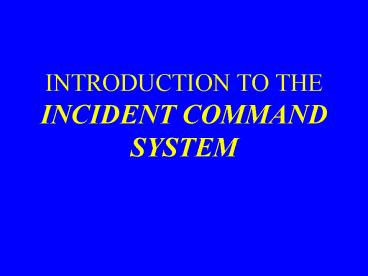INTRODUCTION TO THE INCIDENT COMMAND SYSTEM - PowerPoint PPT Presentation
1 / 41
Title:
INTRODUCTION TO THE INCIDENT COMMAND SYSTEM
Description:
Uses Strategic Incident Planning ... a standard management system for all emergency incident operations. Develops and implements one Incident Action Plan (IAP) ... – PowerPoint PPT presentation
Number of Views:555
Avg rating:3.0/5.0
Title: INTRODUCTION TO THE INCIDENT COMMAND SYSTEM
1
INTRODUCTION TO THEINCIDENT COMMAND SYSTEM
2
Incident Command System
- Emergency Management System
- Applicable to Large/Complex Incidents
- Coordinate Multi-agency and Multi-jurisdiction
Operations - Integrated Communication
- Maximum Effectiveness and Efficiency of Resources
3
EMERGENCY MANAGEMENT
- The difference between a good department and a
poor one in relation to emergency effectiveness
is not equipment or personnel but the quality of
management. - David H. Cowardin
4
Why Command Systems FAIL
- Too much information
- Impaired thinking
- Incomplete communications
- Loss of control
5
Symptoms of System Failure
- Slow or NO response to questions.
- Rejection of feedback.
- Inability to think ahead.
- Considerable lag time to commit resources.
6
WHY USE ICS ?
- Uses Strategic Incident Planning
- All resources operate in a Safe, Effective and
Efficient manner. - Maximizes use of tactical resources
- Avoids conflict and confusion
7
INCIDENT COMMAND SYSTEM
- Provides a standard management system for all
emergency incident operations - Develops and implements one Incident Action Plan
(IAP) - Establishes command and control of all on scene
resources - Provides for the safety and accountability of all
personnel
8
ICS MANAGEMENT CONCEPTS
- MAINTAIN UNITY OF COMMAND
- EFFECTIVE SPAN OF CONTROL
- ALL RESOURCES OPERATE IN A FUNCTIONAL POSITION
9
Effective Incident Management
- Identify the Problem
- Delegate Tactical Command
- Assign Every Problem
- Allocate Resources
10
COMPONENTS OF ICS
- Common Terminology
- Modular Organization
- Integrated Communications
- Unified Command Structure
11
COMPONENTS OF ICS
- Consolidated Action Plan
- Manageable Span of Control
- Predesignated Incident Facilities
- Comprehensive Resource Management
12
BALANCE IAP and ICS
- ACTION PLAN What needs to be done.
- ORGANIZATION Who does it.
13
ELEMENTS OF ICS
- COMMAND
- OPERATIONS
- PLANNING
- LOGISTICS
- FINANCE
14
COMMANDProvides overall management of the
incident
- Responsible for Incident Activities
- Develop and Implement Strategic Decisions (IAP)
- Approves the Ordering and Releasing of Resources
15
Incident Command System
16
Unified Command Element
- A Unified Team which allows all agencies with
management responsibilities to function as
Command.
17
Members of the Unified Command
- Work as a Management Team
- Designated Agency Leader
- Decision Making Authority
- Adhere to Agency Policy
18
OPERATIONS SECTION
- Responsible for the management of all operations
directly applicable to the primary mission. - Activates and supervises organization elements in
accordance with the IAP
19
(No Transcript)
20
Planning Section
- Responsible for the collection, evaluation,
dissemination and use of information about the
development of the incident and status of
resources.
21
(No Transcript)
22
LOGISTICS SECTION
- Responsible for providing facilities, services
and material in support of the incident.
23
(No Transcript)
24
FINANCE SECTION
- Responsible for all financial and cost analysis
of the incident.
25
(No Transcript)
26
Managing Large and Complex Incidents
- Extending the ICS Organization
27
Modified version of the ICS organization to meet
the needs of a large and complex incident
- Complex Command
- Area Command
28
Extending the ICS for Very Large Incidents
- Operations Section is not large enough to
accommodate adequate resources under
span-of-control guidelines. - Logistical Support can no longer be maintained
adequately. - Incident becomes too large for a single IAP
29
Operational Resources ExceedSpan-Of- Control
- Activate additional Operations Section(s)
- Larger than 5 Branches
- Appoint Deputy IC for Operations
- Coordinate 2 or more Operations Sections
30
(No Transcript)
31
Logistical Support CannotBe Maintained
- One Incident Base cannot support the logistical
needs of the entire incident - Activate additional Logistics Section(s)
- Appoint Deputy IC for Logistics
- Coordinates 2 or more Logistics Sections
32
(No Transcript)
33
Incident is too large for a Single IAP
- No logical set of objectives for the entire
incident. - Additional Planning Section is NOT RECOMMENDED
- Branch level Action Planning
34
Planning Section Provides to each Branch
- Incident general objectives
- Specific Branch Objectives for operational period
- Resource summary
- Technical information
- Changes in logistical support
35
Branch Directors
- Perform detail action planning.
- Branch planning is supported by Planning personnel
36
Complex Command
37
AREA COMMANDAUTHORITY
- Coordination of Operations, Planning and
Logistics for Multiple Incident Commands
38
Area Command
- Incident covers an extensive geographic area
- Planning and Logistics are very complex
- Divide Incident into 2 commands
- Inter-Incident Coordination
- May change priorities of any incident
39
AREA COMMAND
40
CONSIDERATIONS forEXTENDED ICSORGANIZATION
- Size or complexity of the incident
- SEE Principle
- Cost effectiveness
- Ability to expand present ICS
41
Incident Command System
- Emergency Management System for Field Response.
- Incident Action Plan
- Command Organization
- Comprehensive Resource Management
- Delegates Decision Making































